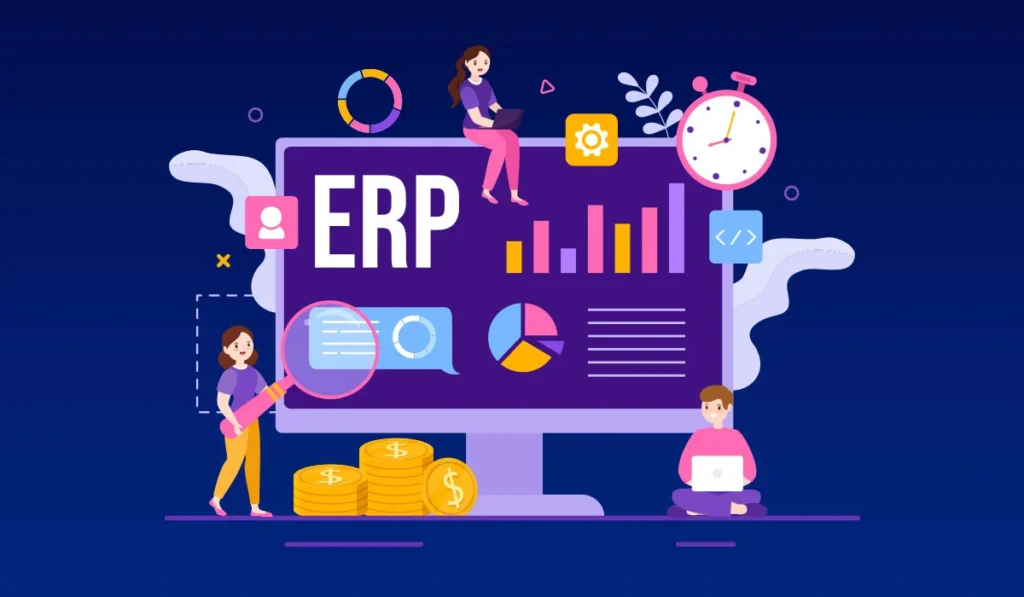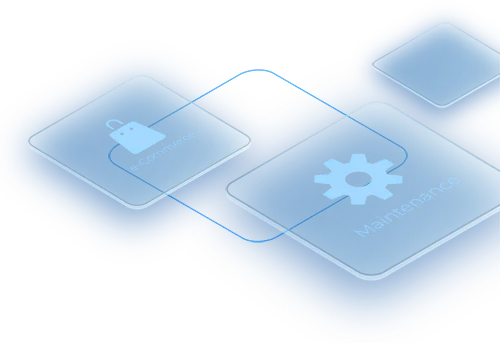
Key Steps to Success in ERP Implementation Strategies

Key Steps to Success in ERP Implementation Strategies
An Enterprise Resource Planning – ERP system can be an effective strategy for businesses seeking to streamline operations, enhance efficiency, and drive growth.
However, implementing an ERP system is a complex undertaking that requires careful planning and execution.
This comprehensive guide will explore more about the difficulties and simple steps for successful ERP implementation.
We will also provide you with insights into common pitfalls that you can avoid while implementing an ERP system in your organization.
Content Index
- What Is ERP Implementation?
- 9 Steps To a Successful ERP Implementation
- How to Select an ERP Implementation Strategy
- Common ERP Implementation Mistakes To Avoid
- Conclusion

What Is ERP Implementation?
ERP implementation is the comprehensive process of integrating an Enterprise Resource Planning (ERP) system into an organization’s existing infrastructure and operations.
This process is designed to centralize and streamline various business functions, such as finance, human resources, supply chain management, etc. into a unified system.
The ultimate goal of ERP implementation is to improve efficiency, enhance data accuracy, and provide real-time insights across the organization.
The steps for successful ERP implementation include key phases such as selecting the right ERP software and configuring it to suit the organization’s specific needs.
It also involves migrating data from legacy systems and ensuring employees are properly trained to use the new system.
Each phase must be carefully planned and executed to ensure a smooth transition and to minimize disruptions to the business.
A successful ERP implementation automates tasks, enhances decision-making with better data access, and fosters cross-departmental collaboration.
The process is complex and requires careful planning, resource allocation, and ongoing support to achieve the desired outcomes.
Success in ERP implementation relies on managing change, communicating effectively with stakeholders, and providing workforce training and support.
9 Steps To a Successful ERP Implementation
Successful ERP implementation depends on a well-defined strategy and meticulous execution.
Following the key steps for successful ERP implementation is crucial to ensure a smooth transition and to maximize the benefits of your new system.
Here’s a step-by-step breakdown
Assess Current Systems
The first and foremost step in a successful ERP implementation is to conduct a thorough assessment of your current systems.
This involves evaluating the strengths and weaknesses of your existing software, understanding the data structure, and identifying any gaps in functionality.
By doing so, you can determine what needs to be improved and how the new ERP system can address these issues.
Define the Scope and Goals
Clearly defining the scope and goals of the ERP implementation is crucial.
Establish what you aim to achieve with the new system, such as improving operational efficiency, enhancing data accuracy, or reducing costs.
Set specific, measurable, achievable, relevant, and time-bound (SMART) objectives to guide the implementation process and measure success.
Choose an ERP System
Selecting the right ERP system is a critical decision that can affect your organization’s growth and success.
Consider factors such as the system’s functionality, scalability, ease of integration with existing systems, and vendor support.
For example, EBR’s ERP Software solution offers robust features tailored to various industries, including customizable modules, seamless integration capabilities, and strong customer support.
Conduct thorough research, evaluate multiple options, and involve key stakeholders in the decision-making process to ensure that the chosen ERP system aligns with your business needs.
Configure Your ERP System
Once you’ve selected an ERP system, the next step is to configure it to fit your organization’s requirements.
This involves setting up the system’s modules, defining user roles and permissions, and customizing features to match your business processes.
Proper configuration ensures that the system operates efficiently and supports your specific operational needs.
Prepare and Migrate Data
Data migration is a critical phase and one of the essential steps for successful ERP implementation.
Prepare your data by cleaning and organizing it to ensure accuracy and consistency.
Migrate data from legacy systems to the new ERP system, ensuring that all relevant information is transferred and properly integrated.
This step is vital for maintaining data integrity and ensuring a smooth transition, making it a crucial part of the overall implementation process.
Test the ERP System
Thorough testing of the ERP system is essential to identify and resolve any issues before full-scale implementation.
Conduct various types of testing, including functional testing, integration testing, and user acceptance testing.
Address any problems that arise and ensure that the system performs as expected in real-world scenarios.
Train Employees on the New ERP System
Effective training is key to the success of ERP implementation and ensures that employees are fully equipped to use the system effectively.
Provide comprehensive training to employees on how to use the new system, including its features, functionalities, and best practices.
Ensure that training is tailored to different user roles and is ongoing to address any questions or challenges that arise.
These steps for successful ERP implementation help ensure a smooth transition and maximize system efficiency.
Organize regular follow-ups to reinforce learning and address evolving needs.
Implement the New ERP System Fully
After successful testing and training, proceed with the full implementation of the ERP system.
Transitioning from the old system to the new one involves ensuring that all users are utilizing the new ERP system.
It also includes addressing any issues that may arise during the transition period.
A well-executed rollout minimizes disruptions and ensures a smooth shift to the new system.
Provide Ongoing Maintenance and Support
The final step in successful ERP implementation is to establish a plan for ongoing maintenance and support.
Regularly update the system, address any technical issues, and provide continued training and support to users.
This ensures that the ERP system remains effective, secure, and aligned with your organization’s evolving needs.
How to Select an ERP Implementation Strategy
Choosing the right implementation strategy is crucial for success.
Even if you follow the correct steps for successful ERP implementation, an unsuitable strategy can lead to significant challenges and setbacks.
Consider the following factors when deciding on your approach
Organizational size
The size of your organization can influence the complexity of the implementation process.
Assess how the scale of your organization affects the complexity and scope of the ERP system.
Larger organizations may require a more gradual, phased approach, while smaller organizations might opt for a quicker, more straightforward implementation.
Risk tolerance
Evaluate your organization’s risk tolerance when choosing an implementation strategy.
Determine how much risk your organization is willing to accept during the implementation process.
A high-risk tolerance might allow for a faster, more aggressive strategy, while a lower tolerance may necessitate a more cautious approach.
A more conservative approach may involve a longer implementation period with extensive testing, while a more aggressive strategy may focus on rapid deployment.
Desired pace of return on investment (ROI)
Carefully consider and determine how quickly you expect to see a return on your investment.
If rapid ROI is essential, you might choose a strategy that accelerates deployment, even if it involves more upfront risk or cost.
A faster implementation might offer quicker benefits but could come with increased risks.
In contrast, a slower approach may provide more time for thorough planning and testing.
Cost
Consider the cost implications of different implementation strategies.
Evaluate your budget and financial resources to choose the most feasible strategy.
Your strategy should align with your financial constraints while still achieving the desired outcomes.
A phased implementation might spread costs over time, while a full-scale implementation could require a larger initial investment.
Balancing cost with benefits will help you select an approach that maximizes value.
Common ERP Implementation Mistakes To Avoid
To ensure a successful ERP implementation, be aware of these common pitfalls
Underestimating the Complexity of the Project
ERP implementation is a complex process that requires careful planning and coordination.
Underestimating the complexity can lead to unforeseen challenges and delays.
Always ensure that you have a clear understanding of the project’s scope and the resources required to manage it effectively.
Not Having a Clear Plan and Timeline
A lack of a clear plan and timeline can result in disorganization and inefficiencies.
Develop a detailed project plan with defined milestones and deadlines to keep the implementation on track.
Regularly review and adjust the plan as needed to address any issues or changes.
Not Having a Dedicated Implementation Team
Successful ERP implementation requires a dedicated team with the right expertise.
Failing to assemble a skilled team can lead to significant delays and suboptimal results.
Appoint a project manager and involve key stakeholders from various departments to ensure that all aspects of the implementation are covered.
Not Providing Adequate Training
Inadequate training can hinder the effective use of the new ERP system.
Invest in comprehensive training programs to ensure that employees are well-prepared to use the system.
Ongoing training and support will help users adapt to the new system and address any issues that arise.
Not Providing Ongoing Support and Maintenance
ERP systems require ongoing support and maintenance to remain effective.
Neglecting this aspect can lead to performance issues and decreased user satisfaction.
Establish a plan for regular updates, technical support, and system maintenance to ensure long-term success.
Conclusion
Implementing an ERP system is a complex but rewarding process that can transform your organization’s operations.
By following the steps for successful ERP implementation and avoiding common mistakes, you can maximize the benefits of your new system.
A well-executed ERP implementation enhances operational efficiency and streamlines processes across the organization.
It also positions your organization for sustained growth and success in a competitive business environment.
With the right approach and dedication, ERP implementation can be a game-changer for your organization’s success.
Here are some topics that cover ERP systems in detail. Have a look!
- How to Choose the Right ERP System for Your Business
- Common Challenges in ERP Implementation
- Data Security and Privacy in ERP: Best Practices
- Understanding the Types of Tiers in ERP Systems
Let's Connect!
Are you currently exploring software solutions for your business? 🤔
Great! What’s the single biggest challenge you’d like a software solution to solve for your business? 🎯
💡 Suggested Solution Ideas:
Just one more step! Share your details so our experts can connect with you personally and discuss tailored solutions. 🤝
Thank You for Connecting! 🎉
We've received your information and a specialist will be in touch with you very shortly to discuss how we can help your business thrive.
In the meantime, feel free to browse our resources or reach out if you have immediate questions.
Understood! 🙏
No worries if you're not exploring software solutions right now. Our door is always open if your needs change!
Feel free to explore our other offerings or connect with us anytime.





